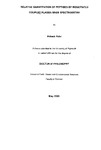RELATIVE QUANTITATION OF PEPTIDES BY INDUCTIVELY COUPLED PLASMA MASS SPECTROMETRY
| dc.contributor.author | Patel, Pritesh | |
| dc.contributor.other | Faculty of Science and Engineering | en_US |
| dc.date.accessioned | 2013-10-08T09:17:55Z | |
| dc.date.available | 2013-10-08T09:17:55Z | |
| dc.date.issued | 2008 | |
| dc.identifier | NOT AVAILABLE | en_US |
| dc.identifier.uri | http://hdl.handle.net/10026.1/2077 | |
| dc.description.abstract |
Currently, the detection/quantitation of biomolecules using Inductively Coupled Plasma Mass Spectrometry (ICR-MS) is focused on heteroatom containing (e.g. S. P, Se, Cu) compounds. This limits the scope of ICP-MS as a routine analytical tool in the bioanalytical sciences. To increase this scope novel strategies to incorporate elemental labels have been developed. Chemical derivatisation is one such strategy. Cyclic diethylenetriaminepentaacetic acid anhydride (cDTPA), a bifunctional chelating agent (BFCA), is reacted with N-terminal amines and is subsequently chelated with trivalent metals. This allows the detection of peptides that contained no heteroatom using liquid chromatography (LC)-ICP-MS. The derivatisation efficiency, optimised using LC-UV/vis detection, is approximately 99%. The derivatisation and chelation reactions products are characterised using LC-electrospray ionisation tandem mass spectrometry (ESI-MS-MS). The labelling procedure allowed the relative quantitation of peptides, by differential isotopic labelling. Two individually derivatised peptide samples are chelated with natural isotopic abundance and isotopically enriched 151Eu respectively. The Eu labelled peptides were combined and analysed by LC-ICP-MS. The resulting 153EU:151EU ratio, measured using the pseudo steady state approach for transient signals; is then used to calculate the original peptide proportions using a modified isotope dilution equation. The ICP-MS measured peptide ratio was within 2.8% of the theoretical peptide ratio. The absolute detection limit for the relative quantitation of Eu labelled bradykinin was 5 pmol, which is comparable to current ESI-MS methods. When cDTPA derivatisation was applied to a complex sample multiple by-products were observed in the LC-UV/vis chromatogram. However, the corresponding LC-ICP-MS chromatogram suggested that only singly derivatised peptides were chelated with the metal. To overcome by-product formation monoreactive BFCAs, namely isothiocyanate-benzyl- EDTA (SCN-Bz-EDTA) and isothiocyanate-benzyl-DTPA (SCN-Bz-DTPA). were evaluated as derivatisation reagents. Solid phase analytical derivatisation (SPAD) and solid phase extraction (SPE) were also evaluated for speed and ease of use. The monoreactive nature of SCN-Bz-EDTA and SCN-Bz-DTPA gave singly derivatised peptides when applied to complex samples. However, the resulting derivatisation efficiency was low and no significant improvement in efficiency was noted when SPAD was used. SCN-Bz-EDTA derivatised peptides could not be chelated to trivalent metals, whilst chelation occurred with SCN-Bz-DTPA derivatised peptides. Eu labelled peptides were isolated and selectively extracted by SPE for relative quantitation by LC-ICP-MS. However, due to the instability of the isothiocyanate reagent and instrumental effects the relative error on the measured peptide ratio was greater than 45% when compared to the theoretical ratio. Although the peptide ratio obtained using the SPE method agreed with the ratio from the non extracted sample. | en_US |
| dc.language.iso | en | en_US |
| dc.publisher | University of Plymouth | en_US |
| dc.title | RELATIVE QUANTITATION OF PEPTIDES BY INDUCTIVELY COUPLED PLASMA MASS SPECTROMETRY | en_US |
| dc.type | Thesis | |
| plymouth.version | Full version | en_US |
| dc.identifier.doi | http://dx.doi.org/10.24382/4830 |
Files in this item
This item appears in the following Collection(s)
-
01 Research Theses Main Collection
Research Theses Main


